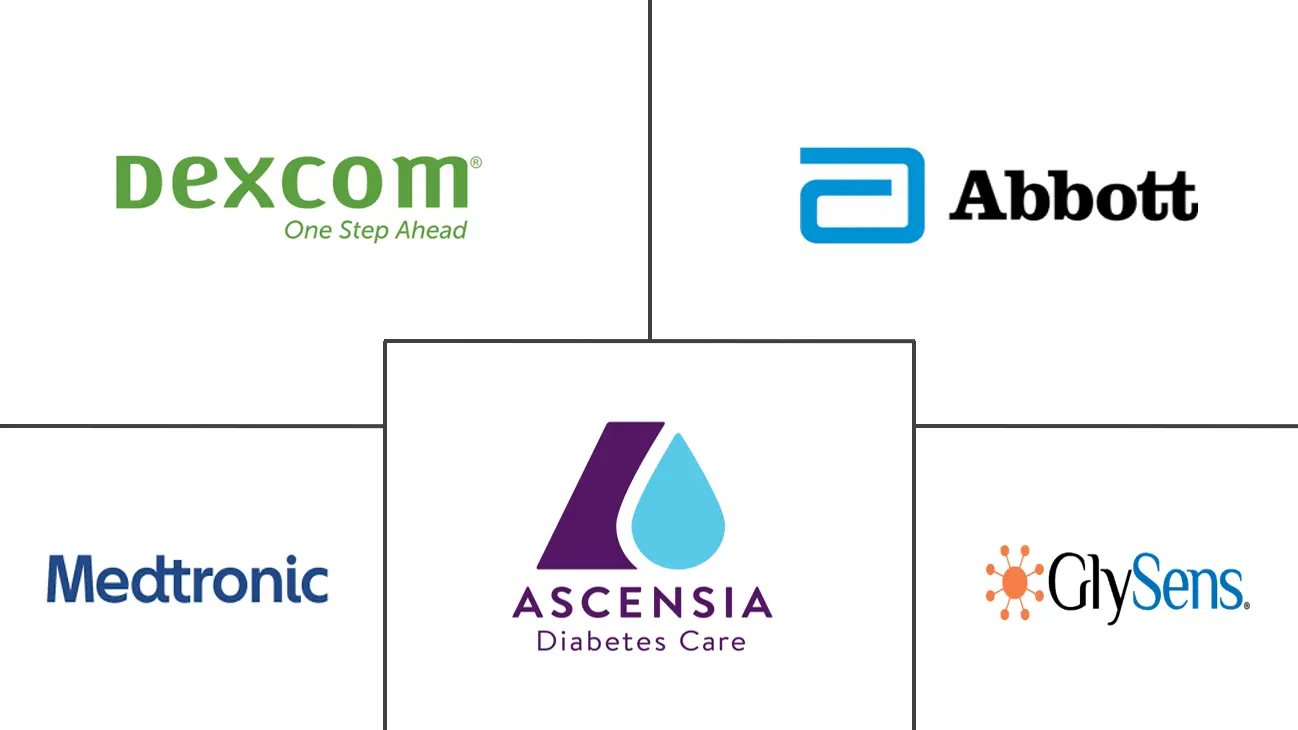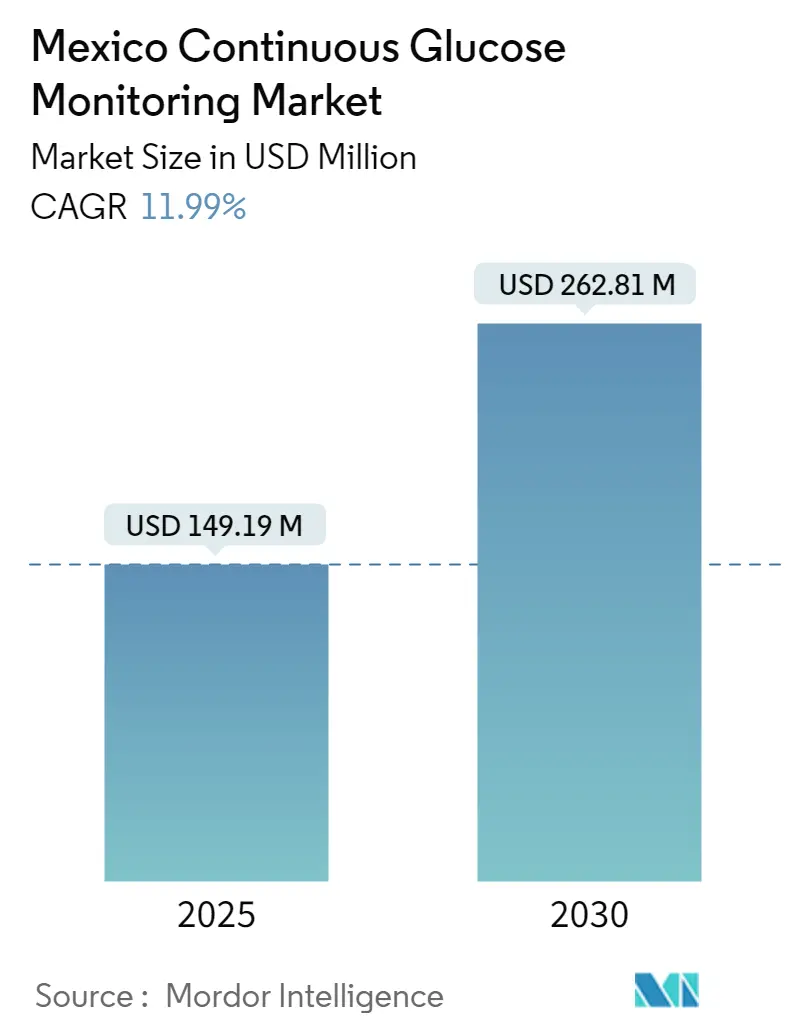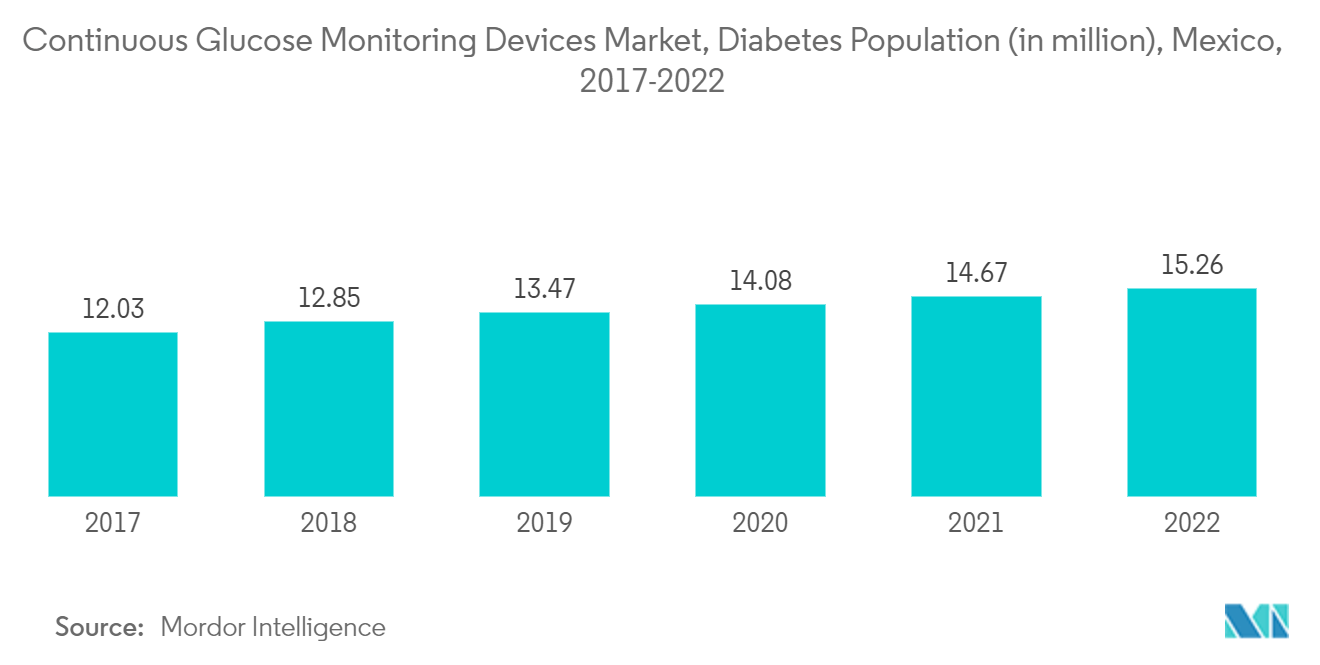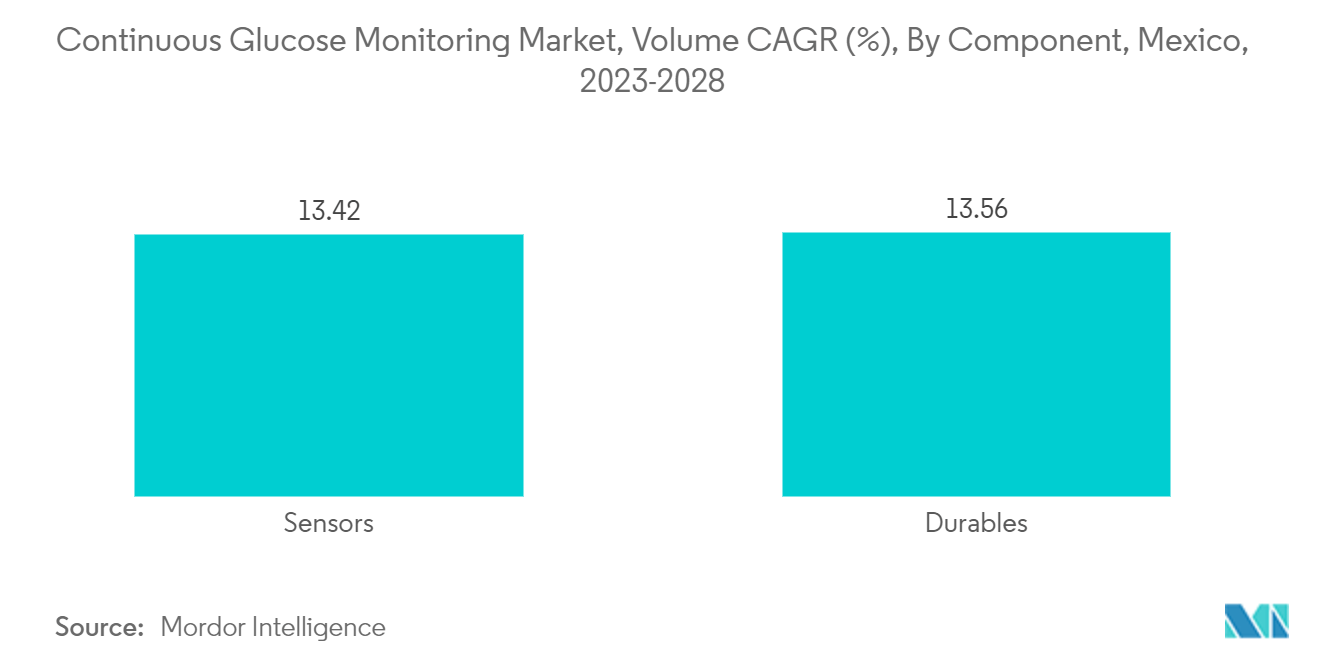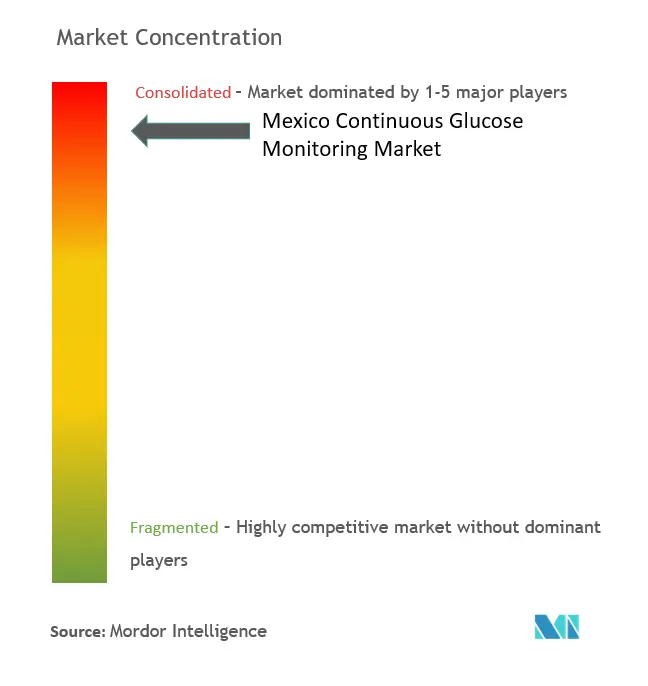Mexico Continuous Glucose Monitoring Market Analysis
The Mexico Continuous Glucose Monitoring Market size is estimated at USD 149.19 million in 2025, and is expected to reach USD 262.81 million by 2030, at a CAGR of 11.99% during the forecast period (2025-2030).
During the COVID-19 pandemic, patients with diabetes were at higher risk for hospitalizations and complications due to hyper- or hypoglycemia, metabolic comorbidities, and more severe illness from SARS-CoV-2 infection. Maintaining euglycemia was important to decrease morbidity and mortality in the hospital setting. The Food and Drug Administration (FDA) allowed the use of CGM devices in the inpatient setting in response to the COVID-19 pandemic. According to experts, inpatient use of diabetes technology in patients with proper institutional protocols was safe and improved inpatient glycemic outcomes and played a vital role in managing hypoglycemia and hyperglycemia in hospitalized patients.
Appropriate and timely monitoring of blood glucose allows the successful management of out-of-range blood glucose levels, minimizing diabetic-related health complications. Continued elevation in blood glucose levels in diabetes patients can contribute to progressive complications such as renal, nerve, and ocular damage. The measurement of blood glucose helps in determining the effectiveness of blood glucose metabolism and guides in achieving optimal glucose control within the body. Over time, the readings provide the patient and their health professionals with the information required to determine the best management strategy for diabetes.
Furthermore, the current continuous glucose Monitoring can either retrospectively display the trends in blood glucose levels by downloading the data or give a real-time picture of glucose levels through receiver displays. The newest CGM models, the Abbott Freestyle Libre 3 and the Dexcom G7, overcame many technical barriers. Technological advances such as Eversense E3 CGMs have significantly improved the ability of providers and patients to manage diabetes, thereby enhancing the market prospects in the years to come.
The World Health Assembly Resolution 2022 recommends the integration of prevention and treatment of diabetes into primary health services, the development of pathways for a substantial increase in access to insulin, the promotion of convergence and harmonization of regulatory requirements for diabetes medicines and technologies, and improved diabetes monitoring and surveillance. Furthermore, it involves the WHO to advise the Member States to ensure the uninterrupted treatment of people living with diabetes in humanitarian emergencies. This important milestone provides a global mandate for diabetes efforts for the next decade.
Mexico Continuous Glucose Monitoring Market Trends
Rising Diabetes Prevalence in Mexico
The Mexican diabetes population is expected to rise by about 3.4% over the forecast period.
According to IDF Diabetes Atlas's latest estimates, the prevalence of diabetes in Mexico reached 16.9%, or one in six adults. An estimated 14.1 million adults in Mexico are living with diabetes. Additionally, 11 million adults in the country have Impaired Glucose tolerance, which places them at high risk of developing type 2 diabetes. Diabetes-related health expenditure in Mexico has reached USD 19.9 billion, putting it in the top ten countries with the highest total health expenditure. About 47.5% of people living in Mexico with diabetes are undiagnosed.
Lack of health insurance deprives people of access to services and puts them at risk of financial hardship. To protect the people against excessive health expenditures, Mexico has implemented mechanisms such as community-based health insurance, national health insurance, and targeted public health insurance. Mexico has multiple health insurance providers. The Instituto de Seguridad y Servicios Sociales de los Trabajadores del Estado (State Employee’s Social Security and Social Services Institute, ISSSTE) provides coverage for government employees, and the Instituto Mexicano del Seguro Social (Mexican Social Security Institute, IMSS) covers for private-sector employees. The Seguro Popular (People’s Insurance) was launched to protect the working-age population against steep healthcare costs. Enrolment in the Seguro Popular is independent of health status or pre-existing illness; there is no co-payment by the type of health care received, and family contributions are determined solely by the ability to pay.
The Ministry of Health also launched a national program for health that integrates efforts for diabetes prevention, education, and control along with a system of primary health clinics focused on the treatment of obesity, diabetes mellitus, high cholesterol, and high blood pressure, with an interdisciplinary team. These clinics developed improved guidelines for the prevention, detection, and control of NCDs with behavioral components. They also use technology to optimize attention and improve monitoring and evaluation.
Therefore, owing to the increasing diabetes prevalence and government support initiatives the studied market is anticipated to witness growth over the analysis period.
The sensors segment is expected to witness the highest growth rate over the forecast period
Continuous glucose monitoring sensors use glucose oxidase to detect blood sugar levels. Glucose oxidase converts glucose to hydrogen peroxidase, which reacts with the platinum inside the sensor, producing an electrical signal to be communicated to the transmitter. Sensors are the most important part of continuous glucose Monitoring. Technological advancements to improve the accuracy of the sensors are expected to drive segment growth during the forecast period.
Researchers are trying to find and develop alternatives to electrochemical-based glucose sensors and create more affordable, minimally invasive, and user-friendly CGM sensors. Optical measurement is a promising platform for glucose sensing. Some technologies have been reported to have high potential in continuous glucose sensing, including spectroscopy, fluorescence, holographic technology, etc. Eversense, a CGM sensor based on fluorescence sensing developed by Senseonics Company, presents a much longer lifespan in comparison with electrochemical sensors.
Diabetes mellitus in Mexico has been declared a national emergency, and the country has designed various control programs, such as the National Strategy for the Prevention and Control of Overweight, Obesity, and Diabetes, based on public health, medical care, and fiscal and regulatory policies. Government actions to control diabetes include communication programs to raise awareness about the disease and the benefits of healthy weight, diet, and physical activity, self-care diabetes campaigns, guidelines to diagnose and control diabetes, development of self-support groups for diabetic patients, and the development of a National Health Card for adults. Such initiatives are expected to create awareness among the people regarding the monitoring and control of diabetes, thereby enhancing the market prospects in the years to come.
The aforementioned factors are set to boost market growth.
Mexico Continuous Glucose Monitoring Industry Overview
The Mexican continuous glucose monitoring market is consolidated, with few significant players. There have been constant innovations driven by manufacturers such as Abbott, Dexcom, and Medtronic while also adhering to organic growth strategies, which is evident from the R&D spending of these companies.
Mexico Continuous Glucose Monitoring Market Leaders
-
Abbott
-
Dexcom
-
Medtronic
-
Ascensia
-
GlySens
- *Disclaimer: Major Players sorted in no particular order
Mexico Continuous Glucose Monitoring Market News
- April 2023: The FDA approved the MiniMed 780G System for modifications to the SmartGuard (SG) Technology and for expanding the indications for use to include the Guardian 4 Sensor. The MiniMed 780G system is intended for continuous delivery of basal insulin (background insulin) at selectable rates and the administration of insulin boluses (a single large dose of medicine) at a selectable amount for the management of type 1 diabetes mellitus in persons seven years of age and older requiring insulin.
- March 2023: Abbott announced that the Food and Drug Administration (FDA) cleared its FreeStyle Libre 2 and FreeStyle Libre 3 integrated continuous glucose monitoring (iCGM) system sensors for integration with automated insulin delivery (AID) systems.
Mexico Continuous Glucose Monitoring Industry Segmentation
Achieving optimum glycemic results can be very difficult without frequent monitoring of blood glucose levels. A continuous glucose monitor tracks blood sugar levels 24 hours a day. It collects readings automatically every five to 15 minutes and detects trends and patterns to provide a complete picture of diabetes.
The Mexican continuous glucose monitoring market is segmented into components (sensors) and durables (receivers and transmitters).
The report offers the value (in USD) and volume (in units) for the above segments.
| Component | Sensors |
| Durables |
Mexico Continuous Glucose Monitoring Market Research FAQs
How big is the Mexico Continuous Glucose Monitoring Market?
The Mexico Continuous Glucose Monitoring Market size is expected to reach USD 149.19 million in 2025 and grow at a CAGR of 11.99% to reach USD 262.81 million by 2030.
What is the current Mexico Continuous Glucose Monitoring Market size?
In 2025, the Mexico Continuous Glucose Monitoring Market size is expected to reach USD 149.19 million.
Who are the key players in Mexico Continuous Glucose Monitoring Market?
Abbott, Dexcom, Medtronic, Ascensia and GlySens are the major companies operating in the Mexico Continuous Glucose Monitoring Market.
What years does this Mexico Continuous Glucose Monitoring Market cover, and what was the market size in 2024?
In 2024, the Mexico Continuous Glucose Monitoring Market size was estimated at USD 131.30 million. The report covers the Mexico Continuous Glucose Monitoring Market historical market size for years: 2019, 2020, 2021, 2022, 2023 and 2024. The report also forecasts the Mexico Continuous Glucose Monitoring Market size for years: 2025, 2026, 2027, 2028, 2029 and 2030.
Our Best Selling Reports
Mexico Continuous Glucose Monitoring Industry Report
Statistics for the 2025 Mexico Continuous Glucose Monitoring market share, size and revenue growth rate, created by Mordor Intelligence™ Industry Reports. Mexico Continuous Glucose Monitoring analysis includes a market forecast outlook for 2025 to 2030 and historical overview. Get a sample of this industry analysis as a free report PDF download.

